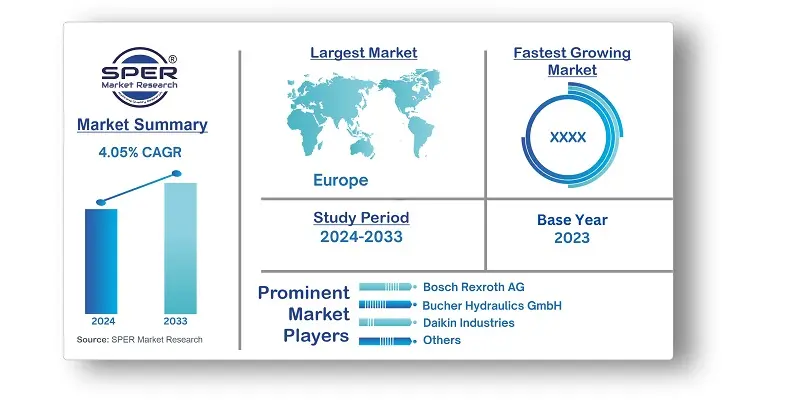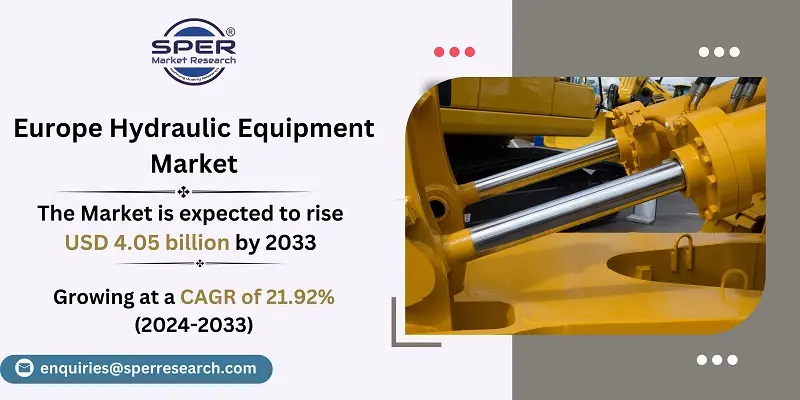
Europe Hydraulic Equipment Market Growth, Size, Trends, Demand, Revenue and Future Outlook
Europe Hydraulic Equipment Market Size- By Component, By End User- Regional Outlook, Competitive Strategies and Segment Forecast to 2033
| Published: Apr-2024 | Report ID: MACH2416 | Pages: 1 - 158 | Formats*: |
| Category : Equipment and Machinery | |||
- HAWE debuted the HICON small hydraulic power pack in August 2022. Designed specifically for recreational boats, it offers a unique advantage in a variety of applications. Because it was watertight, it could withstand brief submersion in water while in use.


| Report Metric | Details |
| Market size available for years | 2020-2033 |
| Base year considered | 2023 |
| Forecast period | 2024-2033 |
| Segments covered | By Component, By End User |
| Regions covered | UK, France, Germany, Italy, Spain, Rest of Europe |
| Companies Covered | Bosch Rexroth AG, Bucher Hydraulics GmbH, Daikin Industries, Ltd., HYDAC Verwaltung GmbH, Linde Hydraulics GmbH & Co. KG, Parker-Hannifin Corp., Poclain Hydraulics SA, Rheintacho Messtechnik GmbH, Weber-Hydraulik GmbH, Others. |
- Construction Industry
- Manufacturing Sector
- Automotive Industry
- Aerospace and Defense Sector
- Agriculture and Forestry Sector
- Mining Industry
- Oil and Gas Sector
| By Component: |
|
| By End User: |
|
| By Region: |
|
- Europe Hydraulic Equipment Market Size (FY’2024-FY’2033)
- Overview of Europe Hydraulic Equipment Market
- Segmentation of Europe Hydraulic Equipment Market By Component (Pumps, Valves, Cylinders, Motors, Filters and Accumulators, Transmission, Others)
- Segmentation of Europe Hydraulic Equipment Market By End User (Construction, Agriculture, Material Handling, Aerospace and Defence, Machine Tools, Oils and gas, Hydraulic, Plastics, Automotive, Others)
- Expansion Analysis of Europe Hydraulic Equipment Market
- Problems and Obstacles in Europe Hydraulic Equipment Market
- Competitive Landscape in the Europe Hydraulic Equipment Market
- Impact of COVID-19 and Demonetization on Europe Hydraulic Equipment Market
- Details on Current Investment in Europe Hydraulic Equipment Market
- Competitive Analysis of Europe Hydraulic Equipment Market
- Prominent Players in the Europe Hydraulic Equipment Market
- SWOT Analysis of Europe Hydraulic Equipment Market
- Europe Hydraulic Equipment Market Future Outlook and Projections (FY’2024-FY’2033)
- Recommendations from Analyst
1.1. Scope of the report1.2. Market segment analysis
2.1. Research data source2.1.1. Secondary Data2.1.2. Primary Data2.1.3. SPER’s internal database2.1.4. Premium insight from KOL’s2.2. Market size estimation2.2.1. Top-down and Bottom-up approach2.3. Data triangulation
4.1. Driver, Restraint, Opportunity and Challenges analysis4.1.1. Drivers4.1.2. Restraints4.1.3. Opportunities4.1.4. Challenges4.2. COVID-19 Impacts of the Europe Hydraulic Equipment Market
5.1. SWOT Analysis5.1.1. Strengths5.1.2. Weaknesses5.1.3. Opportunities5.1.4. Threats5.2. PESTEL Analysis5.2.1. Political Landscape5.2.2. Economic Landscape5.2.3. Social Landscape5.2.4. Technological Landscape5.2.5. Environmental Landscape5.2.6. Legal Landscape5.3. PORTER’s Five Forces5.3.1. Bargaining power of suppliers5.3.2. Bargaining power of buyers5.3.3. Threat of Substitute5.3.4. Threat of new entrant5.3.5. Competitive rivalry5.4. Heat Map Analysis
6.1. Europe Hydraulic Equipment Market Manufacturing Base Distribution, Sales Area, Product Type6.2. Mergers & Acquisitions, Partnerships, Product Launch, and Collaboration in Europe Hydraulic Equipment Market
7.1. Europe Hydraulic Equipment Market Size, Share and Forecast, By Component, 2020-20267.2. Europe Hydraulic Equipment Market Size, Share and Forecast, By Component, 2027-20337.3. Pumps7.4. Valves7.5. Cylinders7.6. Motors7.7. Filters and Accumulators7.8. Transmission7.9. Others
8.1. Europe Hydraulic Equipment Market Size, Share and Forecast, By End User, 2020-20268.2. Europe Hydraulic Equipment Market Size, Share and Forecast, By End User, 2027-20338.3. Construction8.4. Agriculture8.5. Material Handling8.6. Aerospace and Defence8.7. Machine Tools8.8. Oils and gas8.9. Hydraulic8.10. Plastics8.11. Automotive8.12. Others
9.1. Europe Hydraulic Equipment Market Size and Market Share By Region (2020-2026)9.2. Europe Hydraulic Equipment Market Size and Market Share By Region (2027-2033)9.3. UK9.4. France9.5. Germany9.6. Italy9.7. Spain9.8. Rest of Europe
10.1. Bosch Rexroth AG10.1.1. Company details10.1.2. Financial outlook10.1.3. Product summary10.1.4. Recent developments10.2. Bucher Hydraulics GmbH10.2.1. Company details10.2.2. Financial outlook10.2.3. Product summary10.2.4. Recent developments10.3. Daikin Industries, Ltd.10.3.1. Company details10.3.2. Financial outlook10.3.3. Product summary10.3.4. Recent developments10.4. HYDAC Verwaltung GmbH10.4.1. Company details10.4.2. Financial outlook10.4.3. Product summary10.4.4. Recent developments10.5. Linde Hydraulics GmbH & Co. KG10.5.1. Company details10.5.2. Financial outlook10.5.3. Product summary10.5.4. Recent developments10.6. Parker-Hannifin Corp.10.6.1. Company details10.6.2. Financial outlook10.6.3. Product summary10.6.4. Recent developments10.7. Poclain Hydraulics SA10.7.1. Company details10.7.2. Financial outlook10.7.3. Product summary10.7.4. Recent developments10.8. Rheintacho Messtechnik GmbH10.8.1. Company details10.8.2. Financial outlook10.8.3. Product summary10.8.4. Recent developments10.9. Weber-Hydraulik GmbH10.9.1. Company details10.9.2. Financial outlook10.9.3. Product summary10.9.4. Recent developments10.10. Others
SPER Market Research’s methodology uses great emphasis on primary research to ensure that the market intelligence insights are up to date, reliable and accurate. Primary interviews are done with players involved in each phase of a supply chain to analyze the market forecasting. The secondary research method is used to help you fully understand how the future markets and the spending patterns look likes.
The report is based on in-depth qualitative and quantitative analysis of the Product Market. The quantitative analysis involves the application of various projection and sampling techniques. The qualitative analysis involves primary interviews, surveys, and vendor briefings. The data gathered as a result of these processes are validated through experts opinion. Our research methodology entails an ideal mixture of primary and secondary initiatives.



Frequently Asked Questions About This Report
PLACE AN ORDER
Year End Discount
Sample Report
Pre-Purchase Inquiry
NEED CUSTOMIZATION?
Request CustomizationCALL OR EMAIL US
100% Secure Payment






Related Reports
Our Global Clients
Our data-driven insights have influenced the strategy of 200+ reputed companies across the globe.




















